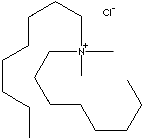PRODUCT IDENTIFICATION

H.S. CODE
TOXICITY
CLASSIFICATION
PHYSICAL AND CHEMICAL PROPERTIES
white powder
Freely soluble
REFRACTIVE INDEX
NFPA RATINGS
Health: 2, Flammability: 3, Reactivity: 0
AUTOIGNITION
GENERAL DESCRIPTION & APPLICATIONS
- Benzalkonium Chloride ( CAS RN: 8001-54-5)
- Benzethonium Chloride CAS 121-54-0
- Cetalkonium Chloride( CAS 122-18-9)
- Cetrimide ( CAS 8044-71-1)
- Cetrimonium Bromide ( CAS 57-09-0)
- Cetylpyridinium Chloride (CAS 123-03-5)
- Stearalkonium Chloride ( CAS 122-19-0)
They have properties of disrupting micro-organisms' cell processes and surfactants. These compounds are used as
- Active Ingredient for Conditioners
- Antistatic Agent
- Detergent Sanitisers
- Softner for textiles and paper products
- Phase Transfer Catalyst
- Antimicrobials
- Disinfection Agents And Sanitizers
- Slimicidal Agents
- Algaecide
- Emulsifying Agents
- Pigment Dispersers
APPEARANCE
CONTENT
30 - 70%
8 (Packing group III)
1993
GENERAL DESCRIPTION OF PHASE TRANSFER CATALYSIS
'Phase transfer catalysis (PTC)' methodology is a powerful tool improving process efficiency, product selectivity and providing mild reaction conditions in organic chemical reactions. In many chemical reaction situations, there are different species (immiscible liquids or solid and liquid) which don't react each othrer due to separattion by an interface. Small quantity of ��phase-transfer catalyst��, involves a substrate (soluble in the organic layer) and an anionic reagent or a nucleophile (dissolved in the aqueous layer), extracts one of the reactants, most commonly an anion, across the interface into the other phase where reaction can take place with the substrate and reaction can proceed. The quaternary ammonium salts can carry the nucleophile from the aqueous to organic phase and are used as the most commonly used as phase-transfer catalyst��. The phosphonium derivatives favoring higher thermal stability property are also used. Crown ethers and polyethylenglycol compounds are also widelt used in this application.
Hexachlorophene and Benzalkonium Chloride are used primarily in hand or face washes. Benzalkonium Chloride must not be applied to areas which have not been fully rinsed as it is inactivated by organic compounds. Benzalkonium application many include disinfecting instruments and preservativing drugs in low concentration form.
Iodine compounds have the widest spectrum of antiinfectives against bacteria, fungi, spores, protozoa, viruses, and yeasts. Aqueous iodine are less effective than alcoholic solutions, but alcoholic component is drying and irritating to abraided skin. Povidone iodine is convenient to use as it is less irritating, but not as effective.
Chlorhexidine is used as a safe antiseptic or disinfectant to apply to prevent body infection and in oral rinses for treating sore gums and mouth ulcers and preventing plaque on teeth. It is used in the form of acetate, gluconate or hydrochloride, either alone or in combination with others such as cetrimide.
Cetrimide is an antiseptic agent with detergent properties. It has the wide spectrum of antiinfectives against bacteria and fungi. It is used as an ingredient of shampoos for treating seborrhoea and psoriasis. A very dilute solution can be applied topically for the relief of sore gums.
Hippuric Acid, an amino acid glycine, is excreted from the body and is used in urinary system drugs. Hexamine hippurates is helpful for preventing and treating infections of the urinary system it acts by being transformed to formaldehyde.
Triclosan is a very popular antibacterial agent. It is used in hospitals for cleansing and disinfecting the skin of patients and surgeons. It is used in cosmetics, household goods and personal care products. It is also used in plastics and textiles for antibacterial activity purpose.
Cetylpyridinium chloride is used in oral rinses for cleaning mouth and treating minor throat or mouth infections and teething problems.
Dequalinium chloride is antiinfectives against bacteria and fungi. It is used in treating bacterial or fungal infections of mouth and throat.
PRICE